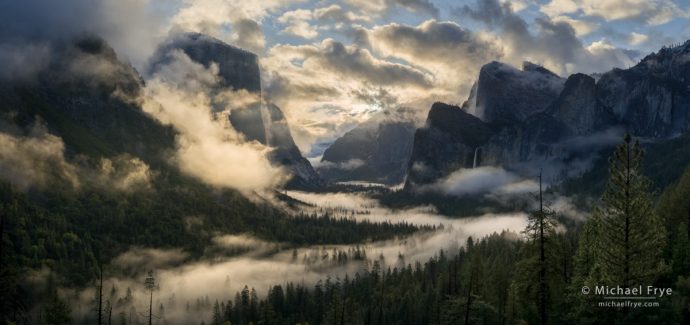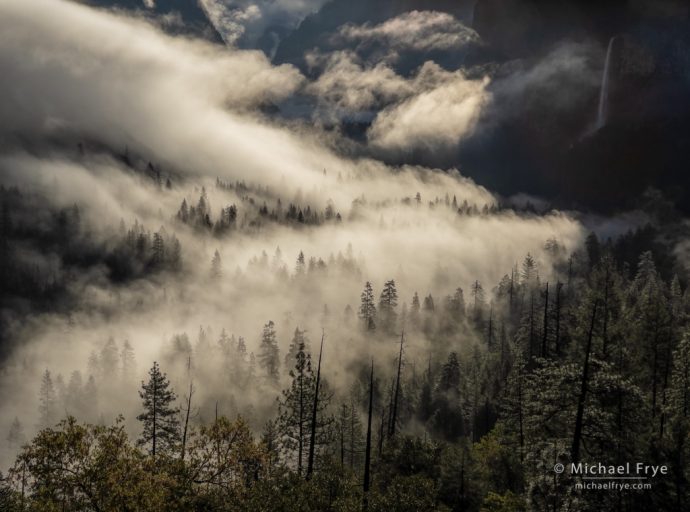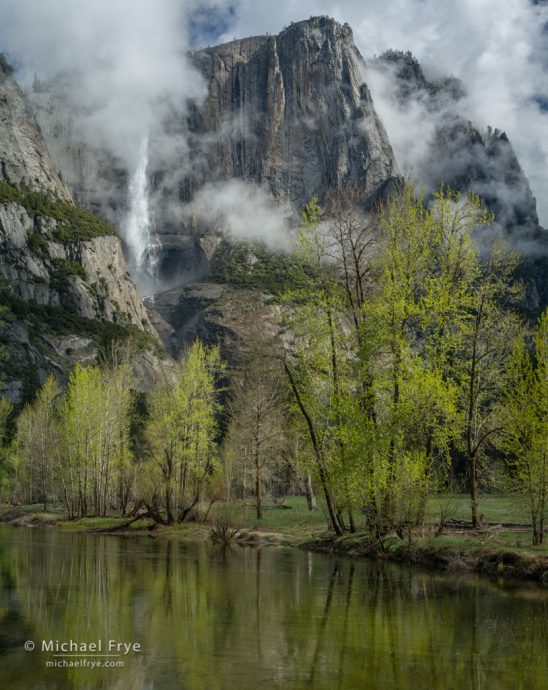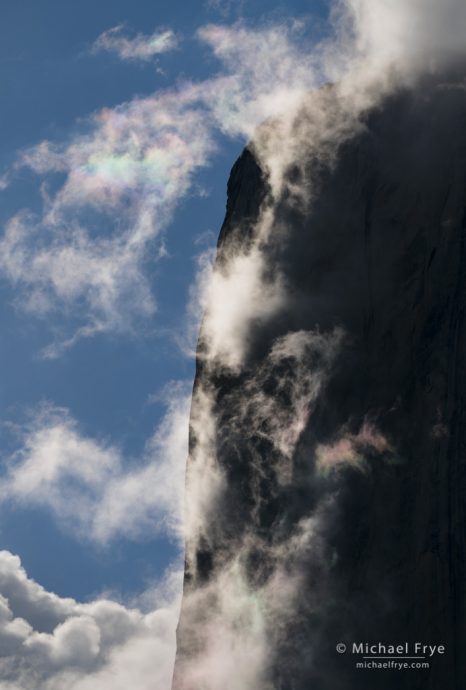Last Sunday, for the first time in over a month, we got some significant rain. Well somewhat significant anyway – half an inch.
It looked like the storm would clear around sunrise on Monday morning, which could be good timing. I drove up to Yosemite Valley early, and, as I often do, went to Tunnel View to get an overview of the valley and assess the conditions.
And the conditions looked promising, with lots of mist, and some higher clouds that could light up at sunrise.
Of course I’ve photographed misty scenes at Tunnel View many times before. I could have decided to go somewhere else perhaps, but under those conditions that seemed like the best spot – the location with the most potential to make interesting, expressive photographs.
It’s a popular spot, so I wasn’t alone. There were only two other people there when I arrived, but by sunrise I’m sure there were at least 20 or 30 photographers. My friend William Neill posted an image on Facebook of all the tripods lined up, and this image spurred some debate. You can read all the commentary here, but the gist of it was that some people couldn’t understand why anyone would want to photograph this scene that’s been photographed so many times before.
It’s a good question. And especially for someone like me, who’s photographed that scene many times before. Why would I want to photograph it again?
I think the primary reason is because I enjoy it. I had a great time there Monday morning. It was so much fun photographing that scene under those conditions. And it was incredibly beautiful. I’ve been to Tunnel View many, many times, under all kinds of amazing lighting conditions, but I never get tired of seeing such beauty. That morning was exceptional, and I’m glad I got to experience it.
I remember telling my friend Karl Kroeber that I didn’t want to visit The Wave, because it’s been photographed to death. And he said, “Yeah, but it’s so amazing. It’s one of the wonders of the world.” And that made me pause. Perhaps I was actually missing a wonderful experience because I was only considering the place through the lens of photography, and the desire to make photographs that were “different” and “original.”
I have similar feelings about Horsetail Fall. I understand why many photographers won’t go near Horsetail in February. Why deal with all the crowds of other photographers just to make a photograph like everyone else’s? But Horsetail is absolutely amazing. The photographs don’t do it justice – not even close. Viewing Horsetail under the right conditions is an incredible experience.
In my photographs I try to capture the beauty of nature in all its forms, big and small, well-known and seldom seen. I’d prefer to avoid crowds, and I enjoy finding new, never- or seldom-before photographed locations. But I also don’t go out of my way to avoid an iconic spot if that seems like the best location at a given time.
I don’t particularly care if a certain scene or subject has been photographed by other people before. All I care about is whether I’m inspired by it. I’d rather not repeat myself, if possible, so if I can find a new location, or new subject, or new way of seeing a familiar place, that’s great. But I’m not driven by the need to be “different” at all costs. First and foremost, I want to enjoy myself. And I enjoy myself most when I follow my instincts and photograph whatever I’m inspired to photograph, without worrying about how the resulting images might compare to other people’s images, whether “it’s been done before,” or any of that external mental baggage.
I hope that somewhere along the way I make photographs that are original – for me. But I find that works best (again, for me) if it’s an organic process, not a conscious effort to do something different.
And just because I photograph a lesser-known spot doesn’t make the style of the image different or original. I think we all bring our way of seeing to whatever location we visit, so while the scenery may have changed, the point of view is the same. I think it’s actually more challenging to make photographs that are different or original (for you) in a familiar location than to do what you always do in a different location.
That morning at Tunnel View was a wonderful experience. It was so beautiful. And while I didn’t have it to myself, I embraced the social aspect of it, chatting with William Neill, and running into someone I didn’t expect to see there, Josh Cripps – all the way over from Mammoth.
As the light and clouds shifted I captured wide views of the whole scene, and tighter views of mist and trees. Later I ventured into the valley and photographed many other scenes, big and small. I had a great day, and to me, that’s what matters most.
— Michael Frye
Related Posts: Photographing an Icon; A Spring Sunrise
Michael Frye is a professional photographer specializing in landscapes and nature. He is the author or principal photographer of The Photographer’s Guide to Yosemite, Yosemite Meditations, Yosemite Meditations for Women, Yosemite Meditations for Adventurers, and Digital Landscape Photography: In the Footsteps of Ansel Adams and the Great Masters. He has also written three eBooks: Light & Land: Landscapes in the Digital Darkroom, Exposure for Outdoor Photography, and Landscapes in Lightroom: The Essential Step-by-Step Guide. Michael has written numerous magazine articles on the art and technique of photography, and his images have been published in over thirty countries around the world. Michael has lived either in or near Yosemite National Park since 1983, currently residing just outside the park in Mariposa, California.













Lovely images, Michael. I think some people just had sour grapes because they haven’t seen light like that at Tunnel View. If someone is in Yosemite and can’t get excited by light like this then perhaps it’s time to take up a new hobby. I also saw quite a few “Ansel already did it best” comments on Bill’s FB feed. The way I see it, who cares if Ansel Adams or someone else did amazing work there? Just do you.
Thanks Richard. “Just do you” – exactly.
Michael, Well said. I have lived across the mountain from Grand Teton NP for more than 5 years. I drive over the pass for sunrise quite often and stop in at a number of places (e.g., Schwabacher’s Landing) many many times. Am I looking for a “brand new photo”? Kinda, but not really. The opportunity to see these places brings joy to me even if I don’t take any photos … but I always try to get those unique images … just like you at Tunnel View. It’s not just about getting a good image; it’s about soul cleansing.
Thanks Randy. “It’s not just about getting a good image; it’s about soul cleansing.” Well said.
Thanks for sharing your philosophy on this subject. Very well stated. Great to see old friends there. My student wasn’t really into being at the tunnel for sunrise, as many of his past instructors told him to avoid the icons. He told me later that that morning was a revelation for him, learning not to deny himself such pleasures!
Thanks Bill! Great to see you there, and I love the images you posted from that morning. And interesting that our student said that!
Michael,
Your words really resonated with me… Often, perhaps always, the places or scenes that make it into our camera lens are only a small portion of the total event. To be inspired, to be in the presence of the amazing, is much more than bringing home a photograph, even if it is “the money shot” (though that is a bonus). We receive something internal as we seek photos, whether they be new or the familiar… I drive the same road to work every day, as I have for the past 13 years… And that drive is never the same… To get or seek a shot that everyone else also got is not a bad thing, because along with the photo, you will come away with an experience that is yours & makes you the unique individual that you are…
Thanks so much for sharing your thoughts here David. Well said.
Thanks Micheal, for sharing your beautiful images. I feel that mist can create a scenery that makes well photographed and iconic locations like Tunnel View still very beautiful to photograph.
Thank you Hong!
Great point Michael, with your experience and you know the area and where to photograph rather it’s crowded with Photographers or not so crowded. I dislike the crowd and it’s hard for me to concentrate on what I’m photographing. I never experienced visiting Yosemite. might need you to show me the place. ( Just kidding.) “Just do You” is a good word, I will always remember this.
Thanks Randy. I think most photographers would prefer to go to uncrowded locations, and I definitely do that on many occasions. Maybe I’m just in the mood to be by myself. But in some instances I feel that desire to be alone might actually keep me away from the best photo spot for the conditions, so maybe that’s a time to embrace the social aspect of it. I do understand also that some people (many?) don’t concentrate as well with other people around. For me that’s not so much a function of the number of people near me, as whether I know them or not. If I’m photographing with friends that can actually break my concentration more, since I might be talking with them, or worry that they’re ready to move on when I’m not, and so on. It’s easier to ignore strangers. 🙂
Hi Michael – First of all, beautiful shots! Secondly, it was so nice to run into you while I was coming back from the 3 brothers that Monday. I have had your book for quite a few years now and you have been a huge inspiration to me. I was actually the first tripod on scene at the tunnel that Monday and I was surprised at how many folks turned up on a Monday morning in late April, but it seemed that at least two different workshops were there that morning. Even though we had a small crowd, it was almost gratifying in a way to have other folks nearby as the valley lit up to turn to and ask “Are you SEEING THIS??” But I agree that it can get a bit too crazy. As soon as the sun hit me in the face, I was off to find other corners of the park and was soon very much all alone enjoying that spectacular morning with only the sound of rushing water and birds calling. It’s definitely more restorative to be in that park alone, and my LEAST favorite times are situations like the Saturday prior when there was a 90 minute backup as the rangers closed off sentinel bridge and sent everyone up to Curry Village. What a nightmare. If folks can get into the park during off peak times, it makes a world of difference. As for the tunnel, I’ll still be shooting from up there for many years to come, but hopefully on days when most of the crowds have gone home.
Thanks Bill, and nice to run into you too! And as I said to Randy above, I completely understand the desire to avoid crowds. That’s especially true when crowds impact your experience in other ways – like traffic jams, or not being able to find a good spot to set up your tripod, and even find a parking spot (which can happen at Tunnel View). But as a nature photographer, you want to connect with nature, and that’s more likely to happen when you’re alone or in a small group.